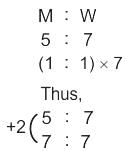UGC NET Paper 1 Mock Test - 9 - UGC NET MCQ
30 Questions MCQ Test UGC NET Mock Test Series - UGC NET Paper 1 Mock Test - 9
Given below are two statements, One is labelled as Assertion (A) and the other is labelled as Reason (R) :
Assertion (A):- Doing Interdisciplinary research is more challenging than that in within any single discipline.
Reasons (R) :- It is not possible to combine knowledge from two disciplines.
In the light of the above statements, choose the correct answer from the options given below :
Find the value of (81 - 3k), where k is the average value of 21, 25, 26, 29 and 34.
Which of the following Indian universities were modelled on the lines of University of London?
A. Calcutta
B. Bombay
C. Madras
D. Andhra
E. Mysore
Choose the correct answer from the options given below:
A man is walking at a speed of 14 km/h. After every km, he takes rest for 7 minutes. How much time will he take to cover a distance of 7 km?
The university that was considered the learning center for royal princes during the Gupta period in ancient India was
Which of the following statements is/are true regarding ROM?
A) ROM is volatile memory
B) ROM is typically used for the storage of firmware like BIOS
C) ROM can be easily rewritten or modified
D) ROM refers to the main memory used by programs in execution
Choose the correct answer from the options given below:
Lord Curzon, as Viceroy of India, implemented substantial educational reforms. Among these was the Indian Universities Act of 1904. What was one of the key changes brought about by this Act?
A) It set a uniform curriculum for all universities in India.
B) It established a system for affiliating new universities to the British education system.
C) It marginally decreased governmental control over universities.
D) It increased governmental control over universities.
Choose the correct answer from the options given below:
Given below are two statements:
Statement I: In a ratio scale, zero point is arbitrary.
Statement II: The nominal scale allows ordering/ranking of data.
In the light of the above statements, choose the correct answer from the options given below
The ratio of number of men and women in a ice-cream factory of 840 workers is 5 : 7. How many more men should be joined to make the ratio 1 : 1?
With regards to synchronous online classroom communication which of the following statements are incorrect?
a) Encourage live participation and interaction through online classes.
b) Enables response flexibility.
c) Have to be extremely clear and detailed with the subject matter.
d) More time for subject matter reflection.
Choose the answer from the options given below
The following statements are either True or False. Choose the correct statement(s) from the codes given below :
What method should be used if researcher wants to know how different levels of independent variable affect the dependent variable at different levels of another independent variables?
(a) Analysis of covariance method.
(b) Two-way analysis of variance.
(c) Multiple correlation method.
(d) Factorial analysis of variance method.
Find out the wrong number in the series.
445, 221, 109, 46, 25, 11, 4
Which of the following best describes the key feature of Open Educational Resources (OER)?
By giving a 10% discount on an article, there is a profit of 20%, if this discount is increased to 20%, then what will be the profit percentage?
The production of car 'E' in the year 2016 was approximately what percent of the production of car 'B' in the year 2019?
What was the approximate percentage decrease in production of car 'D' from 2018 to 2021?
Which type of cars manufactured by company X during 2016 to 2021 is the maximum?
What was the approximate percentage increase in the production of car 'A' from 2016 to 2021?
Which instrument was instrumental in the Chandrayaan-1 mission for revealing water molecules on the lunar surface?
What spectral regions did the Chandrayaan-1 mission aim to explore for high-resolution remote sensing of the lunar surface?
Which method of the qualitative research focuses on language and meanings that are given to texts, for the purpose of creating and shaping knowledge and behaviour?
|
92 docs|125 tests
|















